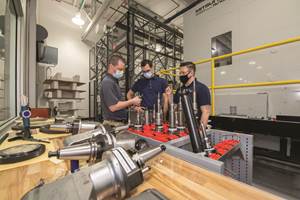Thread Rolling Heads Keeps The Wheels Of Racing Turning
During an auto race, where fractions of a second mean the difference between winning and losing, nobody wants to stop and examine the thread quality of a wheel stud. Yet wheel stud threads are extremely important, especially when you consider that the driver's safety and millions of dollars are at stake.
During an auto race, where fractions of a second mean the difference between winning and losing, nobody wants to stop and examine the thread quality of a wheel stud. Yet wheel stud threads are extremely important, especially when you consider that the driver's safety and millions of dollars are at stake.
With this in mind, Curtis Goodman, President of MSI Racing Products, does everything in his power to produce high quality products that go unnoticed during race time. MSI, located in Troutman, North Carolina, manufactures wheel studs and nuts for some of the best racing teams in the world, including the Winston Cup and Busch Grand National teams. Mr. Goodman rolls all his threads and forms his knurls on CNC machines with thread rolling heads and attachments from Fette (Brookfield, Wisconsin).
"We're in a business where compromise is never a consideration," he explains. "We have to put out the best product possible. It's far too risky to take shortcuts. A customer doesn't return bad products--in our case--he loses races."
Thus, the quest for reliable, uncompromising quality was the primary motivation behind Goodman's decision to use Fette heads and attachments. Thread rolling produces stronger threads than thread cutting because the grain of the metal is not cut. Of course, it does take on a new shape, but as the metal is compressed, its density increases and the material actually becomes stronger than it was in its unrolled state. The slicing action of thread cutting, on the other hand, results in material which is weaker than its original state.
An additional benefit of thread rolling is the absence of burrs. Rolled threads have a smooth, polished surface finish with no sharp or jagged edges. For MSI's wheel studs, the integrity of the thread is of utmost importance because wheel studs must be capable of withstanding multiple pit stops without failure.
Even though high quality is Mr. Goodman's primary concern, it is not the only benefit he derives from thread forming. Extremely fast cycle times and long tool life are among the others.
For the threading process, he uses a Fette F3 axial thread rolling head on a Mazak Quickturn 15 CNC machine. The wheel studs are made of a specially-coated high tensile alloy, and the thread, approximately 11/4" long, is 5/8 × 18 UNF. Running at 1140 rpm and 120 sfm, threading time is a snappy 1.15 seconds. One set of nitrided Fette thread rolls lasts 6000 parts, which, because of the low cost per set, amounts to a tooling cost of 3.6 cents per piece.
The 0.650" diameter coarse knurl on the stud is produced with a Fette T18 tangential head, also at 1140 rpm. The feed rate is 0.008" per revolution, and the cycle time is just 2.01 seconds. The T18 roll life is 10,000 pieces, which are approximately 3.5 cents per piece. The coolant used for both threading and knurling operations is a commercial water soluble type maintained at 10 percent concentration.
"We're extremely happy with the results we have achieved with Fette's thread rolling heads, as well as the technical assistance we have received from their application engineers," Mr. Goodman stated. "We have depended on them since we began in business and it's a relationship which has paid off by giving us the manufacturing edge drivers need to compete and win."
Related Content
Digital Twins Give CNC Machining a Head Start
Model-based manufacturing and the digital thread enable Sikorsky to reduce lead times by machining helicopter components before designs are finalized.
Read MoreInside the Premium Machine Shop Making Fasteners
AMPG can’t help but take risks — its management doesn’t know how to run machines. But these risks have enabled it to become a runaway success in its market.
Read MoreThreading On A Lathe
The right choices in tooling and technique can optimize the thread turning process.
Read MoreInverting Turning and Five-Axis Milling at Famar
Automation is only the tip of the iceberg for Famar, which also provides multitasking options for its vertical lathes and horizontal five-axis machine tools.
Read MoreRead Next
The Cut Scene: The Finer Details of Large-Format Machining
Small details and features can have an outsized impact on large parts, such as Barbco’s collapsible utility drill head.
Read More3 Mistakes That Cause CNC Programs to Fail
Despite enhancements to manufacturing technology, there are still issues today that can cause programs to fail. These failures can cause lost time, scrapped parts, damaged machines and even injured operators.
Read More






.jpg;maxWidth=300;quality=90)
.jpg;maxWidth=300;quality=90)



.png;maxWidth=300;quality=90)
.png;maxWidth=300;quality=90)












